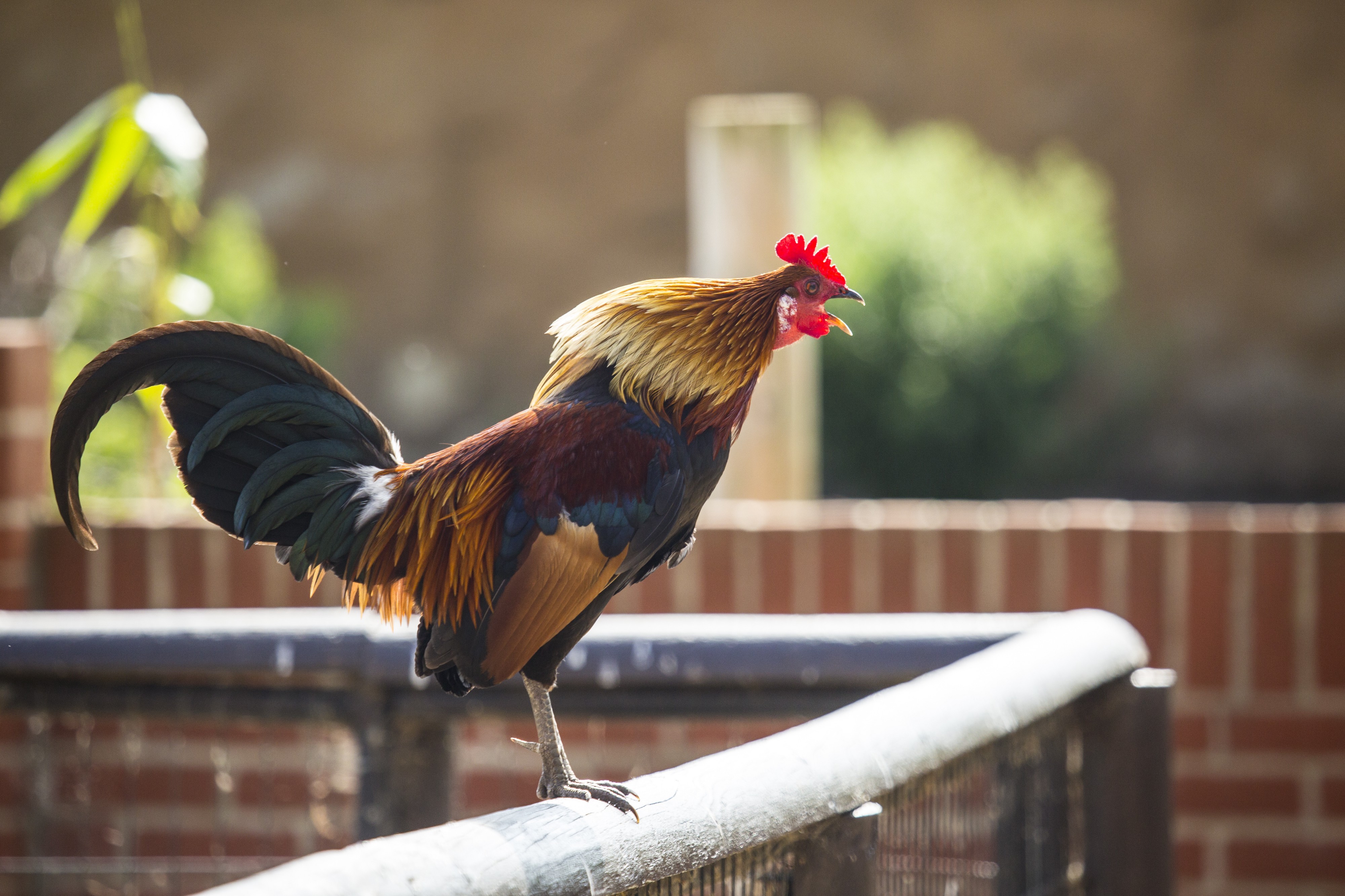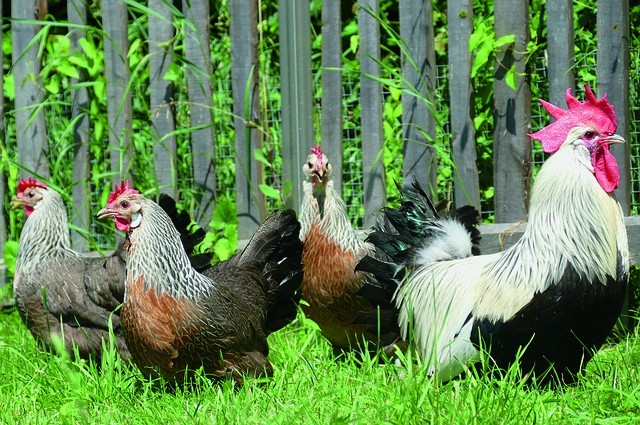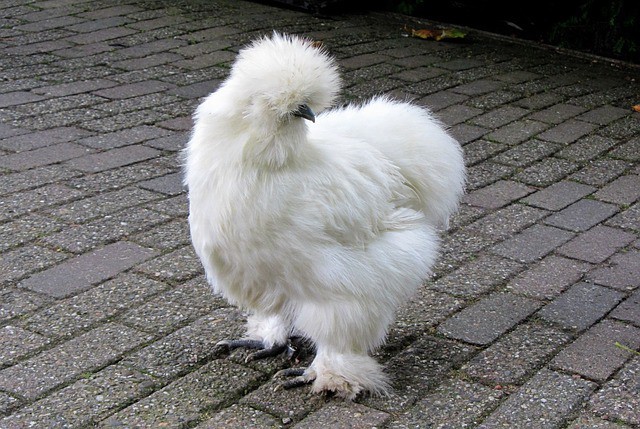Why do roosters crow? The rooster’s crow is a quintessential sound of the countryside, often associated with the break of dawn, but the reasons behind this behavior are more complex than just signaling sunrise. WHY.EDU.VN explores the multifaceted functions of crowing, offering insights into the rooster’s crucial role in the flock and its environment. Exploring the vocalizations, rooster behavior, and chicken communication can help you better understand these fascinating creatures.
1. The Biological Clock and the Rooster’s Crow
One of the primary reasons why roosters crow is deeply rooted in their internal biological clock. This circadian rhythm is not unique to roosters; many animals, including humans, have it. However, in roosters, this internal clock seems particularly sensitive to light, leading them to crow in anticipation of sunrise.
1.1. Circadian Rhythm Explained
The circadian rhythm is a roughly 24-hour cycle in the physiological processes of living beings, including plants, animals, fungi, and cyanobacteria. In the context of roosters, this rhythm regulates various functions, including sleep-wake cycles, hormone release, and, notably, the urge to crow. According to a study published in Behavioral Biology, chickens, including roosters, possess a sophisticated internal clock that allows them to anticipate predictable environmental changes, such as sunrise.
1.2. Light Sensitivity
Roosters’ eyes contain specialized cells that are highly sensitive to light. As the first hints of dawn appear, these cells send signals to the rooster’s brain, triggering a cascade of hormonal and neural events that culminate in crowing. Research from the Journal of Animal Science indicates that even minimal light exposure can stimulate crowing, which is why roosters sometimes crow well before actual sunrise, or even under artificial light conditions at night.
1.3. Environmental Factors
While the internal clock is a primary driver, external factors also play a significant role. The presence of other roosters, sounds, or sudden changes in the environment can trigger crowing. The rooster’s crow isn’t just a response to light, it’s also a way of communicating with and asserting dominance over other roosters in the area.
1.4. Scientific Studies on Rooster Crowing
Several scientific studies have delved into the specifics of rooster crowing. A study conducted at Nagoya University in Japan found that roosters could accurately predict sunrise even when kept in constant darkness, suggesting a robust internal clock mechanism. This research, published in the journal Current Biology, highlighted the complex interplay between internal biological cues and external stimuli in regulating rooster crowing behavior.
1.5. Impact of Artificial Light
The increasing presence of artificial light in urban and suburban environments can disrupt the natural crowing patterns of roosters. Light pollution can cause roosters to crow at unusual hours, leading to conflicts with neighbors and raising questions about the ethical implications of keeping roosters in artificially lit environments.
2. Territoriality and Dominance
Beyond the internal clock, crowing serves crucial social functions for roosters. Roosters are highly territorial animals, and crowing is a primary way they establish and defend their territory. This behavior is essential for maintaining social order within the flock and ensuring access to resources like food and mates.
2.1. Defining Territory
Roosters use their crow as a sonic fence, marking the boundaries of their territory and warning other roosters to stay away. The volume and frequency of crowing can indicate the rooster’s strength and determination to defend its domain. According to ethological studies, roosters respond more aggressively to crows originating from outside their territory than to those from within.
2.2. Dominance Hierarchy
Within a flock, roosters establish a dominance hierarchy, with the most dominant rooster having preferential access to resources and mates. Crowing plays a key role in asserting and maintaining this dominance. The dominant rooster typically crows more frequently and loudly than subordinate roosters, signaling its superior status to the entire flock.
2.3. Challenging Rivals
When a new rooster enters an established territory or a subordinate rooster challenges the dominant one, crowing becomes even more intense. Roosters engage in crowing contests, where they exchange crows in an attempt to intimidate each other. These contests can escalate into physical fights if neither rooster backs down.
2.4. Studies on Aggression and Crowing
Research has shown a direct correlation between crowing frequency and aggressive behavior in roosters. A study in Applied Animal Behaviour Science found that roosters who crow more often are also more likely to engage in aggressive behaviors such as pecking and spurring. This suggests that crowing is not just a territorial signal but also an indicator of a rooster’s overall aggressiveness and dominance.
2.5. Impact on Flock Dynamics
The territorial and dominance-related crowing of roosters has a significant impact on the dynamics of the entire flock. By establishing clear boundaries and maintaining social order, roosters help to reduce conflict and ensure the smooth functioning of the group. This, in turn, can lead to increased productivity and overall well-being for the hens.
3. Communication with the Flock
Roosters don’t just crow to mark territory or assert dominance; they also use crowing as a way to communicate with the hens in their flock. This communication can serve various purposes, from alerting the hens to danger to signaling the availability of food.
3.1. Alarm Calls
One of the most important communication functions of crowing is to alert the flock to potential threats. Roosters have distinct alarm calls that they use to warn the hens of approaching predators such as hawks, foxes, or even domestic dogs. These alarm calls are typically louder and more urgent than regular crows, prompting the hens to seek cover.
3.2. Food Calls
Roosters also use specific calls to signal the discovery of food. When a rooster finds a particularly tasty treat, it will often emit a series of soft, rapid clucks that attract the hens to the food source. This behavior is particularly important for young chicks, who rely on the rooster to lead them to food.
3.3. Mating Displays
Crowing is also an integral part of rooster mating displays. Roosters will often crow while strutting around a hen, spreading their wings, and performing a courtship dance. This behavior is designed to attract the hen’s attention and signal the rooster’s readiness to mate.
3.4. Research on Chicken Vocalizations
Extensive research has been conducted on chicken vocalizations, revealing a complex system of communication. Studies have identified over 30 distinct vocalizations in chickens, each with its own specific meaning. This research highlights the sophistication of chicken communication and the important role that roosters play in maintaining flock cohesion.
3.5. Impact of Rooster Presence
The presence of a rooster can significantly enhance the well-being and safety of a flock of hens. Roosters provide a valuable early warning system, protect the hens from predators, and help to ensure that the hens have access to food and other resources. In the absence of a rooster, hens may become more stressed and vulnerable to threats.
4. The Rooster’s Crow as a Cultural Symbol
Beyond its biological and social functions, the rooster’s crow holds significant cultural meaning in many societies around the world. The rooster is often seen as a symbol of vigilance, courage, and masculinity, and its crow is associated with the dawn of a new day and the triumph of light over darkness.
4.1. Historical Significance
The rooster has been a prominent symbol in art, literature, and mythology for thousands of years. In ancient Greece, the rooster was associated with the god Apollo, the god of light and music. In Roman culture, the rooster was a symbol of Mars, the god of war. In many cultures, the rooster is seen as a guardian against evil spirits, and its image is often used to ward off bad luck.
4.2. Religious Symbolism
The rooster also holds religious significance in various traditions. In Christianity, the rooster is often associated with the apostle Peter, who denied Jesus three times before the rooster crowed. The rooster’s crow is seen as a reminder of Peter’s betrayal and a symbol of repentance and forgiveness.
4.3. National Symbolism
In some countries, the rooster has become a national symbol. The Gallic rooster is a national emblem of France, representing the country’s pride, courage, and resilience. The rooster also appears on the coat of arms of several other countries, including Portugal and Zambia.
4.4. Modern Interpretations
In modern times, the rooster continues to be a popular symbol in advertising, sports, and popular culture. The rooster’s image is often used to convey qualities such as energy, enthusiasm, and determination. Its iconic status endures, even as fewer people have direct experience with these birds.
4.5. Impact on Perception
The cultural significance of the rooster and its crow can influence how people perceive these birds. While some may view the rooster’s crow as a nuisance, others see it as a comforting and nostalgic reminder of rural life. Understanding the cultural context of the rooster’s crow can help to promote greater appreciation and tolerance for these unique animals.
5. Addressing Common Concerns About Rooster Crowing
While the rooster’s crow has many positive aspects, it can also be a source of frustration for some people, particularly those living in urban or suburban environments. Addressing common concerns about rooster crowing is essential for promoting harmonious coexistence between humans and these birds.
5.1. Noise Complaints
The most common complaint about rooster crowing is the noise. Roosters can crow frequently and loudly, which can be disruptive, especially in densely populated areas. Many cities and towns have noise ordinances that restrict the keeping of roosters, or at least limit the hours during which they are allowed to crow.
5.2. Mitigation Strategies
There are several strategies that can be used to mitigate the noise of rooster crowing. One option is to keep the rooster in a coop or enclosure that is well-insulated to reduce the amount of sound that escapes. Another option is to provide the rooster with a dark, quiet place to sleep, which can help to reduce its urge to crow early in the morning. Some people also use devices such as “crow collars” to restrict the rooster’s ability to crow loudly.
5.3. Training and Management
While it is not possible to completely eliminate rooster crowing, it is possible to manage the behavior to some extent through training and management. For example, roosters can be trained to associate crowing with specific times or locations, which can help to reduce the frequency of unwanted crowing. It is also important to provide roosters with plenty of space and enrichment to reduce stress and boredom, which can contribute to excessive crowing.
5.4. Legal Considerations
Before acquiring a rooster, it is important to check local ordinances and regulations regarding the keeping of poultry. Many jurisdictions have specific rules about the number of roosters that are allowed, the distance that poultry must be kept from neighboring properties, and the hours during which crowing is permitted. Failure to comply with these regulations can result in fines or other penalties.
5.5. Promoting Understanding
Ultimately, the key to addressing concerns about rooster crowing is to promote understanding and tolerance. Educating neighbors about the benefits of keeping roosters, such as pest control and natural fertilizer, can help to reduce conflict. It is also important to be respectful of neighbors’ concerns and to take steps to mitigate the noise of rooster crowing as much as possible.
6. The Science Behind the Sound
The rooster’s crow is not just a random vocalization; it’s a complex sound produced by a specialized organ in the rooster’s throat. Understanding the mechanics of crowing can provide insights into the rooster’s biology and behavior.
6.1. Syrinx Anatomy
The sound of a rooster’s crow originates from the syrinx, an organ unique to birds that functions similarly to the larynx in mammals. The syrinx is located at the point where the trachea splits into the lungs, and it consists of membranes that vibrate when air passes over them. The rooster can control the tension and vibration of these membranes to produce a wide range of sounds, including the characteristic crow.
6.2. Airflow and Resonance
The process of crowing involves a coordinated effort of the rooster’s respiratory system. The rooster takes a deep breath, then expels the air through the syrinx, causing the membranes to vibrate. The sound is then amplified by the rooster’s trachea and resonating chambers in its head and neck.
6.3. Hormonal Influences
The development and function of the syrinx are influenced by hormones, particularly testosterone. Male chicks begin to develop the syrinx at a young age, but the organ does not reach its full size and functionality until the rooster reaches sexual maturity. Testosterone plays a key role in this process, stimulating the growth of the syrinx and enhancing its ability to produce loud, clear crows.
6.4. Acoustic Properties
The acoustic properties of the rooster’s crow have been studied extensively by ornithologists and bioacousticians. These studies have revealed that the rooster’s crow is characterized by a complex structure, with multiple frequencies and harmonics. The specific characteristics of the crow can vary depending on the rooster’s breed, age, and social status.
6.5. Evolutionary Adaptations
The rooster’s crow has evolved over time to serve specific functions in the bird’s social and ecological environment. The loud, far-reaching sound of the crow is well-suited for signaling territory, asserting dominance, and communicating with the flock over long distances. The complex structure of the crow may also convey information about the rooster’s individual identity and fitness.
7. Rooster Breeds and Crowing Characteristics
Not all roosters are created equal when it comes to crowing. Different breeds of roosters have different crowing characteristics, including frequency, volume, and pitch. Understanding these differences can help people to choose a rooster that is well-suited to their needs and preferences.
7.1. Leghorns
Leghorn roosters are known for their frequent and loud crowing. This breed is highly active and alert, and its crow is often used to signal any potential threat or disturbance. Leghorn roosters are also known for their early maturity, with some individuals beginning to crow as early as four months of age.
7.2. Rhode Island Reds
Rhode Island Red roosters are generally less vocal than Leghorns, but they still have a strong crow that can be heard over long distances. This breed is known for its hardiness and adaptability, making it a popular choice for backyard chicken keepers.
7.3. Silkies
Silkie roosters are known for their gentle and quiet nature. Their crow is softer and less frequent than that of other breeds, making them a good choice for people who are concerned about noise. Silkie roosters are also known for their docile temperament, making them a good choice for families with children.
7.4. Bantams
Bantam roosters are miniature versions of standard breeds, and their crow is typically higher pitched and less powerful than that of their larger counterparts. Bantam roosters can be a good choice for people who have limited space or who want a less intimidating bird.
7.5. Breed Selection Considerations
When choosing a rooster breed, it is important to consider not only the crowing characteristics but also the bird’s temperament, size, and overall health. It is also important to research the breed’s specific needs and requirements to ensure that it will thrive in its new environment.
8. Debunking Myths About Rooster Crowing
There are many myths and misconceptions surrounding rooster crowing. Separating fact from fiction can help people to better understand and appreciate these fascinating birds.
8.1. Myth: Roosters Only Crow at Dawn
One of the most common myths about rooster crowing is that they only crow at dawn. While it is true that roosters often crow early in the morning, they can and do crow at any time of day or night. Crowing can be triggered by a variety of factors, including light, noise, territorial challenges, and communication with the flock.
8.2. Myth: All Roosters Crow Loudly
Another common myth is that all roosters crow loudly. While some breeds of roosters are known for their loud crowing, others are relatively quiet. The volume and frequency of a rooster’s crow can also be influenced by its age, health, and social environment.
8.3. Myth: Crowing Serves No Purpose
Some people believe that rooster crowing serves no purpose other than to annoy humans. In reality, crowing is an essential behavior for roosters, serving important functions such as signaling territory, asserting dominance, and communicating with the flock.
8.4. Myth: Roosters Are Aggressive
While it is true that some roosters can be aggressive, it is not accurate to characterize all roosters as such. Many roosters are gentle and docile, and they can even form close bonds with humans. A rooster’s temperament is influenced by a variety of factors, including its breed, genetics, and upbringing.
8.5. Myth: Hens Need Roosters to Lay Eggs
A common misconception is that hens need roosters to lay eggs. Hens will lay eggs regardless of whether a rooster is present. However, a rooster is necessary for the hen to lay fertile eggs.
9. The Future of Rooster Research
The study of rooster crowing and behavior is an ongoing field of research. New technologies and approaches are providing fresh insights into the complex lives of these birds.
9.1. Bioacoustics
Bioacoustics, the study of sound production and reception in animals, is playing an increasingly important role in rooster research. By analyzing the acoustic properties of rooster crows, scientists can gain insights into the rooster’s physiological state, social status, and communication strategies.
9.2. Genomics
Genomics, the study of genes and their functions, is also providing valuable information about rooster behavior. By comparing the genomes of roosters with different crowing characteristics, scientists can identify the genes that influence this behavior.
9.3. Behavioral Ecology
Behavioral ecology, the study of the ecological and evolutionary basis of animal behavior, is helping scientists to understand how rooster crowing is shaped by the environment and social interactions. By observing roosters in their natural habitats, researchers can gain insights into the adaptive significance of this behavior.
9.4. Welfare Research
Welfare research, which focuses on improving the well-being of animals, is also an important area of study for roosters. By understanding the factors that influence rooster stress and behavior, researchers can develop strategies to improve their living conditions and reduce the negative impacts of human management.
9.5. Potential Applications
The knowledge gained from rooster research has a variety of potential applications. It can be used to improve the management of poultry flocks, to develop more effective strategies for pest control, and to promote greater understanding and appreciation of these fascinating birds.
10. FAQ About Rooster Crowing
Here are some frequently asked questions about why roosters crow:
| Question | Answer |
|---|---|
| Why do roosters crow early in the morning? | Roosters have an internal biological clock that is sensitive to light, causing them to crow in anticipation of sunrise. |
| Do roosters only crow at dawn? | No, roosters can crow at any time of day or night, triggered by various factors such as light, noise, and territorial challenges. |
| How do roosters use crowing to communicate? | Roosters use different types of crows to signal alarm, announce the discovery of food, and attract mates. |
| Is crowing a sign of aggression? | Crowing can be a sign of aggression, particularly when roosters are challenging each other for territory or dominance. |
| Can I stop my rooster from crowing? | It is not possible to completely stop a rooster from crowing, but you can mitigate the noise by providing a dark, quiet place to sleep and using noise-reducing enclosures. |
| What is the syrinx? | The syrinx is a vocal organ unique to birds that allows them to produce a wide range of sounds, including crowing. |
| Do all roosters crow loudly? | No, different breeds of roosters have different crowing characteristics, with some being louder than others. |
| Are roosters important for a flock of hens? | Roosters provide valuable protection and communication for a flock of hens, improving their overall well-being and safety. |
| Why do roosters fight? | Roosters fight to establish and maintain dominance within the flock. |
| How can I introduce a new hen to a flock with a rooster? | Introducing a new hen requires careful management to avoid aggression from the rooster, such as providing separate spaces initially and monitoring interactions closely. |



The rooster’s crow is a complex and multifaceted behavior with important biological, social, and cultural significance. By understanding the reasons why roosters crow, we can gain a greater appreciation for these unique and fascinating birds.
Do you have more questions about rooster crowing or other animal behaviors? Visit WHY.EDU.VN to ask your questions and receive answers from our team of experts. We’re here to help you explore the wonders of the natural world and provide you with the knowledge you need to satisfy your curiosity. Contact us at 101 Curiosity Lane, Answer Town, CA 90210, United States, or reach out via Whatsapp at +1 (213) 555-0101. Let why.edu.vn be your guide to discovery.

